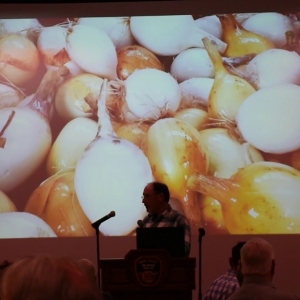Other Ag News: USDA Staffing Crisis: Farm Service Agency Staff Losses Put Farm Safety Net at Risk
On July 24, 2025, US Secretary of Agriculture Brooke Rollins released memorandum SM-1078-015 announcing a proposed reorganization of the US Department of Agriculture (USDA). The proposal was drafted without consultation with farmers or other key stakeholders. Since the beginning of 2025, the agency has already lost more than 20,000 employees, and if implemented, the restructuring could trigger thousands more departures.
In response to a public outcry, USDA opened an ad hoc opportunity for feedback on the proposal. NSAC is encouraging farmers, advocates, and organizations to submit their perspectives on the proposed reorganization to reorganization@usda.gov by September 30, 2025. Still, NSAC remains seriously concerned that USDA has bypassed the standard practice of issuing a Federal Register notice to formally solicit public input on a change of this scale.
This post is the fourth installment in our series examining USDA’s staffing crisis and the ripple effects of the proposed reorganization. Here, we highlight staffing declines within the Farm Service Agency (FSA), where staff reductions threaten to undermine the agency’s ability to administer farm safety net programs, deliver disaster assistance, and provide critical support to farmers across the country. Our earlier posts looked first at overall USDA and state-level staff losses, the implications for the Department’s research agencies, and the loss of staff at the Natural Resources Conservation Service.
FSA Staff Numbers Have Fallen for Two DecadesThe Farm Service Agency (FSA) administers loans and payments to farmers and landowners, operating through a network of more than 2,000 state and county offices. FSA staff help farmers apply for loans, price support programs, income support, disaster recovery, and a variety of other financial support programs. FSA, quite literally, keeps the money flowing for millions of American farms and ranches.
FSA employees include national, state, and county office staff. About ⅔ of FSA employees are county staff, working directly with farmers and landowners in local offices spread across the country. In 2024, for instance, approximately 7,168 employees were FSA county staff and approximately 3,402 were FSA state or national employees.
Figure 1: FSA Staff in FY2024
*While FSA state and national staff are “typical” federal employees, FSA county staff are technically employees of county or community committees and are not considered federal general service employees by the Office of Personnel Management (OPM). Therefore, there is unfortunately much less information available concerning FSA county staff than concerning FSA state and federal staff.FSA staffing levels have steadily eroded over recent decades. Even before the staff losses sustained during the current administration, the number of federal and state FSA staff declined by 43% between fiscal year 2005 and the beginning of fiscal year 2025. The number of county FSA staff declined by 22% during the same twenty year period. The National Association of Farmer Elected Committees recently sounded the alarm that there are now fewer than 6,000 FSA county office employees nationally, a 34% reduction from 2005 staffing levels.
Figure 2: FSA Staff by Fiscal Year
*FSA state and federal staff numbers come from the Office of Personnel Management; FSA county numbers come from USDA annual budget explanations Accelerated FSA Staffing LossesThe FSA has lost at least 1,200 additional employees just since January 2025. Approximately 499 FSA national and state employees and 674 FSA county employees opted to accept the Deferred Resignation Program (DRP). The DRP encouraged federal employees to resign from their positions in exchange for receiving full pay and benefits through September 2025. Approximately 88 additional FSA state and national employees separated from the agency between January and March 2025, according to OPM. Unfortunately, since FSA county employees are not tracked by OPM, it is unknown how many FSA county employees also separated from the agency during this new administration.
Table 1: Recent FSA Staffing Losses
*FSA state and federal staff numbers come from the Office of Personnel Management; FSA county numbers come from USDA annual budget explanationsAltogether, the FSA is entering the 2025 harvest season with at least 12% fewer staff members than in January 2025 and at least 1,100 employees fewer than at the end of the first Trump Administration. Just as farmers and landowners enter a period projected to be extremely economically challenging, the agency that provides their federal financial support has been gutted. The FSA has struggled to administer payments to farmers under the Supplemental Disaster Relief Program of 2025 and the 2023/2025 disaster relief programs, and is navigating the extensive changes to the federal commodity payment programs that were part of the recently passed budget reconciliation process. In addition, there is a growing recognition that supplemental relief will be needed for producers impacted by tariffs, high input costs, and program cuts. The scale of such assistance, likely to be around $20-30 billion, will require significant FSA support to ensure any program is run effectively and payments reach all producers in need. At a time of extremely high demand, these staffing levels will cause distress for the agency and stakeholders.
Every State Hit With FSA Staff LossesSince two-thirds of FSA employees are county staff, the impact of the DRP and staff separations has been felt in every state across the country. Amongst the FSA federal employees, states lost an average of 17% of their FSA staff to the DRP. Two states, Alaska and Delaware, lost the only federal FSA employees in their state to the DRP. The 674 county FSA employees who left their positions to the DRP were spread across 46 states, with Texas (59 employees), Iowa (37 employees), Georgia (36 employees), and Kansas (33 employees) losing the large number of FSA county staff. The map below shows the number of FSA staff lost in each state since January 2025, including both the staff who accepted the DRP and those who otherwise separated from the agency.
Figure 3: FSA Staff Lost to DRP and Separations
!function(){"use strict";window.addEventListener("message",function(a){if(void 0!==a.data["datawrapper-height"]){var e=document.querySelectorAll("iframe");for(var t in a.data["datawrapper-height"])for(var r,i=0;r=e[i];i++)if(r.contentWindow===a.source){var d=a.data["datawrapper-height"][t]+"px";r.style.height=d}}})}();No state has been spared in the gutting of the FSA staff.
Farming Stakeholders Express Their Distress With Staff CutsRecently, The National Association of Farmer Elected Committees (NAFEC) issued a statement expressing their distress and frustration with existing low FSA staffing levels. NAFEC President Jim Zumbrink said: “NAFEC has County Committee members in every county in the nation and the word we are consistently hearing is our county office staffs are critically understaffed…As such, our staff will find it very difficult to perform the complex work of the new Farm Bill, combined with Disaster programs and ongoing programs, with the speed agriculture producers in America, both expect and desperately need.”
Leaders at NAFEC shared that their local offices will be unable to administer existing safety net programs and the forthcoming changes from budget reconciliation and a potential new farm bill. “The new farm bill is going to require millions of new base acres to be established which is going to take a lot of work. We also know that ongoing programs like the Livestock Forage Program (LFP), critical to our nation’s livestock producers, is a program that takes a lot of staff time to administer,” said Kevin Dale, a retired county executive director from a large beef-producing county in Oklahoma. His Oklahoma county office staff has recently been cut from a staff of four full time employees (including one full-time temporary employee) to just two staff members. With those numbers, he says, “Issuing payments quickly under this program will be impossible, without additional staffing.”
FSA staff are highly skilled with extensive institutional knowledge that is lost with these separations. For instance, staff who separated from the agency between January and March 2025 had an average of 18.6 years of service, according to OPM. The decades worth of invaluable experience and institutional knowledge FSA staff carry is essential to serving stakeholders effectively and efficiently. Bob Braden, a NAFEC officer and corn and soybean grower from Iowa says: “With the recent buyouts, not only are FSA offices depleted of warm bodies, but a tremendous amount of knowledge and experience also walked out the door of our offices. Replacing this experience will take a good amount of time.”
NAFEC’s recent public outcry concerning FSA staffing levels follows a July 2025 letter to farm groups highlighting that FSA staffing levels were “already at a breaking point:” “With recent buyouts and early retirements, the staffing levels in our counties has never been lower. Already at a breaking point, we are now faced with having to develop base acres on over 36 million new acres, as well as maintain all of the Title 1 programs that ensure a strong farm safety net. Frankly, we need your help if we are to be able to deliver the farm programs in the fast and efficient manner our producers have come to expect and deserve.”
FSA Staff at a Breaking PointThe steady erosion of FSA staff, combined with the recent surge in losses, has left farmers and landowners with fewer resources and slower access to critical support just at the moment they most desperately need it. Rather than addressing this crisis, the Presidential budget includes massive cuts of more than $372 million to the FSA budget for the next fiscal year and plans to close many local offices. Deputy Secretary Vaden has said there are no plans to ask for either temporary or permanent increases in FSA staff levels, despite widespread stakeholder concerns.
The proposed USDA reorganization will only further exacerbate this staffing crisis by driving even more staff out of the agency. Without a clear plan to rebuild FSA’s workforce, particularly at the county level where farmers most directly depend on assistance, USDA risks undermining the very programs that sustain farm communities in times of need.
The post USDA Staffing Crisis: Farm Service Agency Staff Losses Put Farm Safety Net at Risk appeared first on National Sustainable Agriculture Coalition.
Signup for the Ag Newsletter
Get the freshest farm news, events and updates from in and around Cattaraugus County, NY at least once a month! Go signup!
Other ways to stay connected:
Get Involved in Farming
Resources for Starting a Farm in Cattaraugus County
Profile of Cattaraugus County soils
Agriculture Career Exploration
Questions about farming? Find out Who to Call











